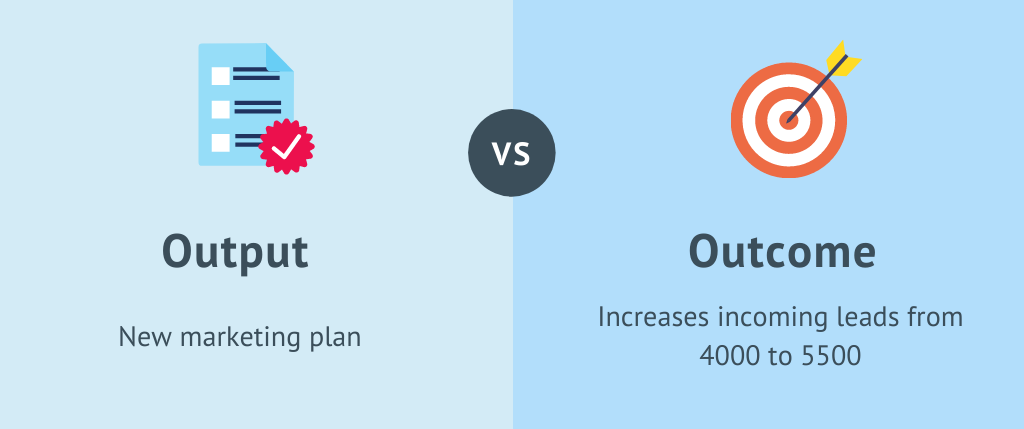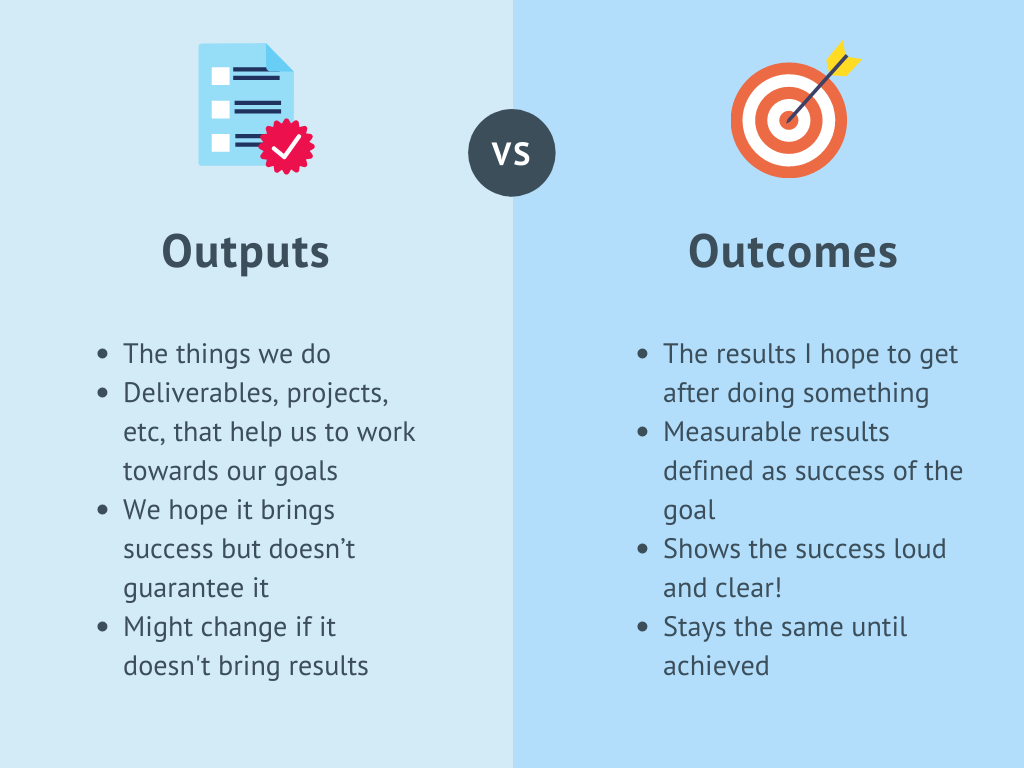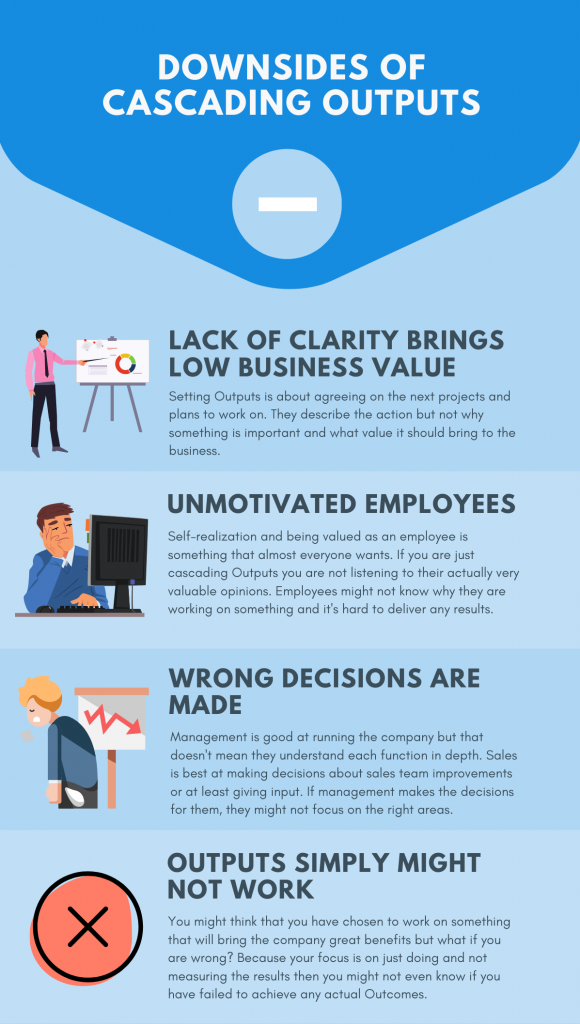Objective and Key Results (OKRs) are often seen as a simple framework with only a couple of principles to follow and achieve your business goals. It’s so much more than that! “Measure What Matters” is great for motivation and overview, but you probably won’t come out a master after reading it.
Many companies make the same common mistakes when implementing OKRs and face the “Outputs vs Outcomes” confusion. They think they are doing OKRs, but in fact, they are not.
That doesn’t mean that companies are not able to understand or learn the OKR methodology. They just seem to be stuck in their old habits. Many people want to use new, popular methodologies, but they are not ready to put in the effort to change and adapt to new ways.
The biggest challenge that most companies face is that instead of defining Key Results as measurable outcomes they set a list of action-based Outputs. This goes against the whole point of OKRs.
In this article, we will go over what is the difference between Outputs and Outcomes, why this topic is even important and we will bring some examples to make things even more clear.
Without further ado, let’s dive into it!
Motivate with OKRs
Show teams how their individual contribution plays a role in the big picture.
What is an Output vs Outcome?
The output is just one term that can be used to describe activities. You can also call them initiatives, plans, projects, deliverables, milestones, tactics, etc. There is a slight difference in those terms, but within OKR methodology they mean the same. Output is an action that you take towards your goals whereas outcomes are the actual deliverables.
Outcomes are the measurable results that you hope to see after you have finished your outputs. Outcomes are not about doing, they are about delivering real, valuable business results. If the marketing plan is our output then the desired outcome of it might be that the new marketing plan increases incoming leads from 4000 to 5500 per quarter.

Everything has its place, so do outputs. They are still important to achieve your goals but it’s not where your focus should be, and it’s not a way to measure success. You need to keep your eye on measurable results that deliver business value. If something doesn’t deliver that success – keep evaluating other options.

Do: Know the Difference
Writing a list of outputs instead of thinking about real business outcomes is one of the main reasons why companies become discouraged by OKRs. They just aren’t actually setting OKRs.
A core value of the OKR methodology is delivering measurable business outcomes. OKRs are about focusing on results that bring real business value instead of just doing different activities. If you are not setting any measurable outcomes, then it’s impossible to see the real benefits of the OKR methodology.
A lot of companies say that “this is the way we do OKRs”. But it’s important to answer the following question:
Why do you put people through all the trouble of changing their workflow and adapting the new OKR method if at the end of the day you keep still doing the same projects and delivering mediocre outputs?
Focusing on outputs is yesterday’s practice. This is what a lot of companies are used to. The management sets its long-term or annual strategic goals and decides on how those will be approached.
Meaning: they set high-level Outputs or KPI targets.
Confusing KPIs & Metrics with OKRs and thinking that one can replace another is a whole another topic, you can watch a video about it below.
After setting the outputs, they are cascaded down and teams are asked to deliver those different projects on certain due dates.
Did anyone even ask why we are working on this?
And has something changed in the business landscape we need to adapt to? Outputs get delivered and the team gets their praise because they are on time. But did everything work out and did these activities bring any business value? Was it even the right thing to do?
Cascading outputs from management onto teams has many other downsides, which eventually results in the company achieving less than it’s actually capable of. The cascaded outputs tend to be complex, long-term plans which can confuse the individuals they are assigned to.
Don’t: Cascade Outputs
Here are some of the most common downsides that your company might face while just trickling down outputs to various teams or individuals.
1. Lack of clarity brings low business value
Cascading outputs mean that people just know what they need to work on but they are missing the “why?”. It’s hard to deliver something good if you don’t even understand what you are fixing here. You can approach one plan from a different angle.
For example, you have to write a new marketing plan. But if you don’t know why then how do you know what areas the marketing should improve? You might decide to focus on cooler ad designs but what the company actually needs might be more high-quality leads. Cooler ads are just cool and attract even more unneeded leads. So no real clarity equals a low business value and you have just wasted a lot of your valuable time.
2. Unmotivated employees
If employees feel that their opinion is not valued in making decisions about the right things to improve, even though they are the experts of some areas in the company, it can cause low work motivation and productivity. If you know more about motivational theories, you would know that self-realization and feeling valued plays an important role in employees’ motivation.
Also, low clarity and not delivering business value might mean that the management is unhappy because things are not actually improving. That dissatisfaction is passed down to the employees who feel that they are just constantly doing something but things are not progressing for better.
Think for a second, how long would you be motivated if you feel that you put in a lot of energy but it just doesn’t work out?
Probably not very long.
Motivate with OKRs
Show teams how their individual contribution plays a role in the big picture.
3. Management decisions are not always the right ones
Even though this is a group of people who are leading the company. It doesn’t mean that valuable input and information can’t come from other employees as well. People who work in certain job positions, like sales, marketing, etc daily are probably the best people who can tell you what seems to be working and what needs improvement in those areas. Management should collect this information and help teams to set and align their goals.
For example, management might see that revenue isn’t coming in as it should and set a goal for sales to get more customers. Just reiterating targets doesn’t make targets happen. You need to think about how you could increase revenue. People in sales, on the other hand, know that they could upsell a lot and should focus on that. Bringing more customers is harder and keeping old ones adds more long-term value.
4. Outputs might simply not work
Upper-level might think that they have chosen to work on something that will bring the company a great benefit but what if they are wrong? If you are focusing on the action and not the results that you are hoping for then how do you know when you are off track? I believe that time is valuable and why spend your time just on doing things if focusing on results could help you choose the right things to work on.
If you want to be the next Google you need to be ready to adapt OKRs as they are. Not just calling what you’re doing OKRs without really putting in any effort.

Outcomes are Key Results
Outcomes are the measurable Key Results and the success indicators of your Objective. When the Objective defines the direction and the focus then the Key Results help you to understand what you are looking to achieve. Key Results measure the success to know when you have achieved your Objective.
Let’s continue with the new marketing plan example.
Your company realized that you need more leads so you could sell more to your potential customers. Marketing wants to write a new marketing plan to try to increase the leads. In that case, your marketing team Objective might be “Increase our brand awareness to bring in new leads”. The new plan is just a way how to approach this. From this Objective we can see that we need to define Key Results in at least two areas:
1)What measurements will show that we have done a good job sharing our brand, and
2)How many new leads are we hoping to get?
Depending on which works best for your company, there are many ways how to measure if you have made your brand visible to new audiences. If you have a blog you could set a KR saying “Increase blog new visitors by 35%”. And you could try to be more visible in social networks as well by setting a KR “Increase Linkedin average post views from 40k to 56k”.
Here your first thought might be that we will set a Key Result to publish one new post per week… but, that is an Output, not an Outcome!
Because maybe the article is bad and no one shares it. Or it doesn’t start ranking in search engines and it doesn’t reach many people. In that case, we can’t anyhow say that we have increased our brand awareness. Focus on the outcomes! If the article did not bring the results then let’s analyze why and try a new approach.
When it comes to getting more leads, think about what you actually want. Do you want just more leads or do you want leads that actually convert to customers as well? I would bet my money on the last one. That means if you do not know yet which kind of leads have the highest chance of ending up as customers, then it’s time to look into it. You should start by defining the requirements for Marketing Qualified Leads (MQL). Based on that we can set a new Key Result saying “Increase Marketing Qualified Leads (MQL) from 3000 to 4400”.
Again, any generated lead doesn’t count, but only the ones that match the MQL criteria.
And here we have our Objective with proper, measurable, outcome-based Key Results:

Keep asking “Why?”
As you can see from the example above, setting Key Results is like being a curious 5 years old who is continuously asking “BUT WHY?”. The why questions are good to take your mind from the first ideas that usually are considered outputs to a more deep understanding of the actual needs. The “why?” is the Outcome we need for the business.
If you are stuck with setting outcome-based Key Results. Ask someone to keep asking you “but why” and continue the dialogue until you are happy with what you are hearing. Let’s go through more examples.
Sales example:
(Bad) KR: “Implement new sales process”
But why?: “Because our results are too low right now”
But why?: “Because our sales take too long and we can’t sell enough in one month”
Now we got it! Our Outcome isn’t that we have the new process, this is our output! The real outcome that we are looking for is that we could close our sales faster. We just need to define how fast is enough.
Our KR could be something like “Reduce lead to closed sale average time from 14 to 10 days”. If the new process doesn’t bring results immediately, we need to keep improving it until we have reduced the days. We keep the focus on the measurable outcome!
Product Team example:
(Bad) KR: Update our in-product onboarding tips
But why?: “Because customers do not follow them”
But why?: “There seems to be too many and they get tired of them”
We got it! What we actually want is to have fewer but useful onboarding tips so customers would complete them all. We could set two good Key Results from that. One focuses on making onboarding shorter: “Reduce onboarding steps from 15 to 7”. And the other makes sure that now customers are really completing them: “Increase onboarding steps completion rate from 20% to 56%”. If you focus on just updating the tips it may not make any difference. You need to understand why you are doing this and does it really helps.
👉 Read more about how to write good OKRs and get some real-life OKR examples to re-use for your team!
Outcomes Drive Business Forward
Remember that an Output is an action or a delivered project, document, etc. It just shows that something is done! An outcome is a measurable result that basically helps you to see if something you did brought any business value. You need to start focusing on Outcomes because this is what drives the business forward, motivates people, and brings in more clarity for the people in your company. Outcomes also help you to define which projects are important to work on now. Without seeing results you can stop wasting your valuable time on something that isn’t worth the trouble.
Now do a practical exercise yourself. Check your team KR’s under the Objective, is there a number in it? If not then most probably you have an Output instead of Outcome. And if there’s a number, still make sure that you aren’t just measuring the number of tasks but the desired outcome of those tasks. Remember, keep asking “but why?”
👉You don’t have any OKRs set yet? No problem! Weekdone is the tool you need to learn, implement & track OKRs.